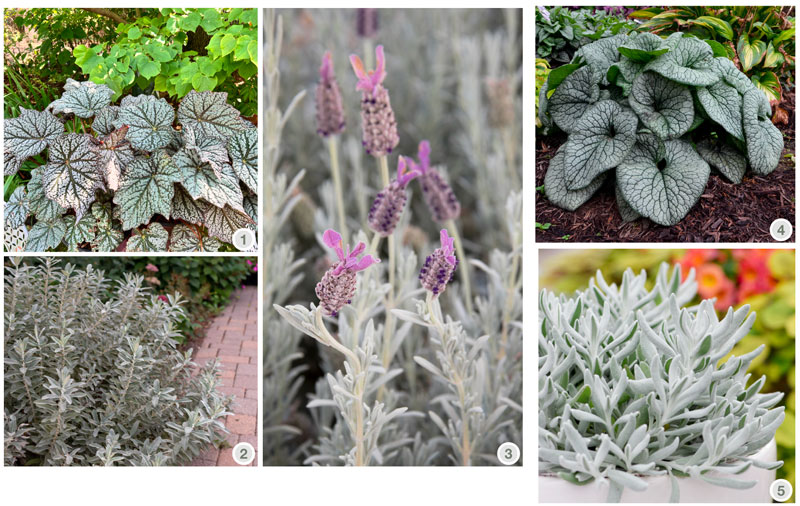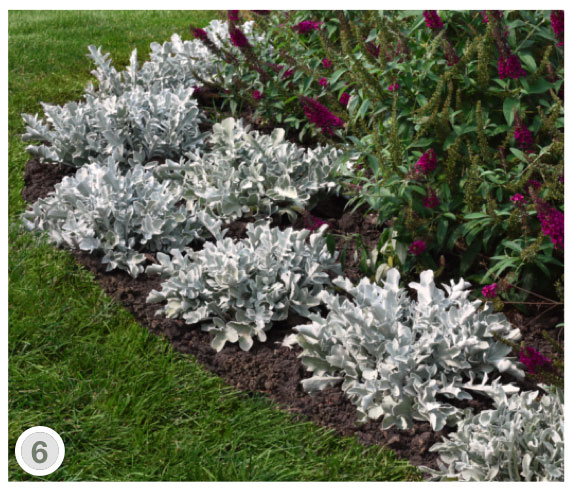1/1/2024
Trendspotting: Is Silver the New White?
Katie Elzer-Peters
The first time I saw Angel Wings Senecio, I knew it would be a hit. It was so unlike any other plant on the market at the time—in a good way. Its big, velvety leaves looked like rabbit ears begging to be stroked. The soft, silvery foliage immediately popped out of every display, from container spotlights to mass groupings designed to beckon trade show browsers.
The plant’s sheer size was intriguing, not unlike a 3-lb. gummy bear or an oversized giraffe at FAO Schwarz. “LOOK AT ME!” it all but screamed from its pots. It hit European markets in 2017 and received its U.S. plant patent in December that year. Did silver foliage plants really take off once Angel Wings started flying off the shelves?
Trend Watching
My gut said yes because I feel like I see these plants everywhere and have only seen more of them. Plenty of new introductions (we’ll get to those) sport silvery leaves and eucalyptus (which, if you squint, falls into this whole not green, but not black foliage category) is hot, hot, hot!
Data is always good for a gut check, so I plugged some terms into trends.google.com to see what people were looking for online.
This is the order that I searched about searches:
Silver plants (Blue: Barely a blip)
Black plants (Red: Yes! Goth gardeners are not a new phenomenon, though that IS trending up.)
Silver foliage (Yellow: A blip. People don’t know the word foliage.)
White plants (Purple: HECK YES! GIMME)
White leaves (Green: Neck and neck with white plants)
Taking out black plants and adding white flowers to the comparison showed white flowers roughly in between white leaves and white plants.
Interesting! Some of the increased interest in white leaves and plants over black plants from 2019-onward is likely because of the reinvigorated houseplant market, which prizes variegated plants. (By the way, the note about changes in search measurement for 2019 is related to geographical attribution.)
That Word Doesn’t Mean What I Think You Think It Means
Here’s why I think that search data is interesting. People are clearly interested in what they call “white plants.”
How many of those “white plants” are what we’d call “silver?” (Someone do a study!) My gut says those two terms are probably interchangeable in the minds of most casual plant buyers, which gives you great opportunity to do what Angela Treadwell-Palmer, co-owner of Plants Nouveau said, “Use silver plants like you use white flowering plants and you’ll enjoy that lightness all season. I used Sterling Moon silver begonias in the two urns on my side porch and they were fabulous because you can see them in the dark!”
The next time someone comes looking for white impatiens or vinca, steer them toward your silver begonias. If they’re nosing around the ornamental grasses, but want a little more year-round structure, point them to Iceberg Alley, a shrubby native willow from First Editions. It’s also a great choice for lamb’s ear enthusiasts that want a more well-behaved plant.
Kathleen Hennessy, VP at Bellmont Partners and a long-time collaborator with Monrovia echoes the need to help customers see what’s possible. “You’ll want to carefully and deliberately merchandise these [silver] plants. Give customers design ideas. Try creating an end cap with dark or purple foliage plants and silver foliage plants so that customers can see how well they pair.”
Maybe “white” is the only word your customer has to describe the overall effect they want to achieve. You can help them find the silver in the rough.
Beware of Location
Which plants will work best for your customers depends highly upon where you’re located and your surrounding climate. Seattle’s best silver standouts are definitely going to be different than perfect picks for Charleston.
Tracee Lund, founder & owner of Potted Pleasures, a boutique container and cut flower gardening service in Charleston, South Carolina said, “Oh! I knew you were going to ask me about Angel Wings!” when I asked her for her favorite plants. “It just melts here,” she said. “I love it, but I can’t use it!” There are plenty of other silver selections that sparkle in her hot, humid climate.
“I absolutely hoard lamium in the spring. It is essential for shady corners,” she said, adding her other favorites include artemisia, which she noted is “outstanding for adding texture.”
Helen von Stein Lamb’s Ear has proven to be better behaved and less prone to melting than other types. In Charleston, window boxes adorn nearly every house and Silver Falls Dichondra is Tracee’s go-to for those. For a double whammy of texture, she’ll mix licorice plant (helichrysum) and artemisia for contrasting textures. For a silver shrub layer she favors pineapple guava and olive trees.
“On the whole, it’s much easier to use silver plants now because there are many improved varieties of old favorites available,” she said.
Sil

ver Linings
Here’s a variety of options to showcase in contrast with dark-leaved plants in 2024.
1. Begonia Lunar Lights Sterling Moon from Southern Living Plant Collection: This one jumped out at me during Cultivate’23. Its large leaves really do look white and have pronounced green veins and burgundy-pink undersides. It’s winter hardy in Zones 7 to 9, which makes it extra useful.
2. Iceberg Alley Sageleaf Willow from First Editions: This native shrub is a little larger and sturdier than an artemisia, but also has a soft, mounding look. It tolerates pruning well and is super cold hardy. Ryan McEnaney from Bailey Nurseries said, “Since we introduced Iceberg Alley, we have had a lot of conversation about it. People are very excited because it softens the look of gardens with a lot of dark foliage. They also like the silvery color with a bigger shrub form. We’ve had lots of interest for it from home gardeners and landscapers in cold regions.”
3. Silver Anouk Spanish Lavender from Monrovia: All lavender has a silvery cast to its foliage, but this one is really silver! It’s compact and evergreen.
 4. Queen of Hearts Brunnera from Proven Winners: Brunnera is an underutilized plant, as far as I’m concerned. Nothing lights up shady spots like these perennials. Queen of Hearts has larger leaves than most and more silvery color with fewer veins. It’s cold hardy to Zone 3.
4. Queen of Hearts Brunnera from Proven Winners: Brunnera is an underutilized plant, as far as I’m concerned. Nothing lights up shady spots like these perennials. Queen of Hearts has larger leaves than most and more silvery color with fewer veins. It’s cold hardy to Zone 3.
5. Didelta hybrid FanciFillers Silver Strand from Westhoff: A nice little semi-succulent that acts as a filler for container gardens. Exceptionally drought- and heat-tolerant. This one caught Jen Polanz’s eye at Cultivate’23.
6. Centaurea Silver Swirl from Darwin Perennials: A foliage plant that has larger leaves than many others that fulfill its function as a border or container annuals. It’s just as large and soft as our Angel Wings friend, but creates more texture due to its lobed leaves. GP
Katie Elzer-Peters is the owner of The Garden of Words, LLC, a green-industry digital marketing agency. Contact her at Katie@thegardenofwords.com.